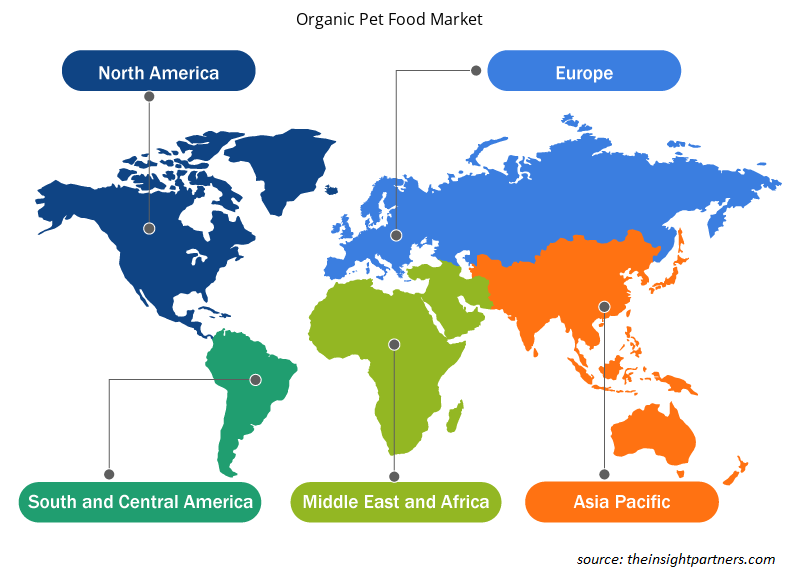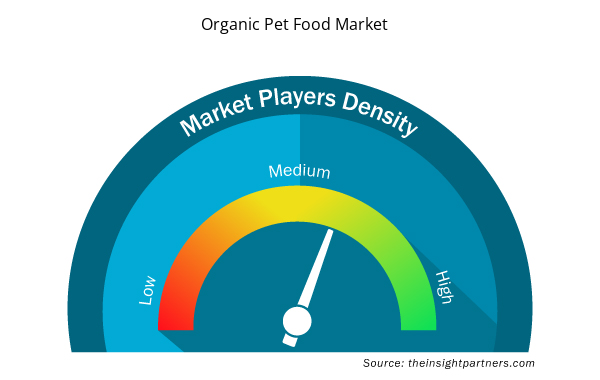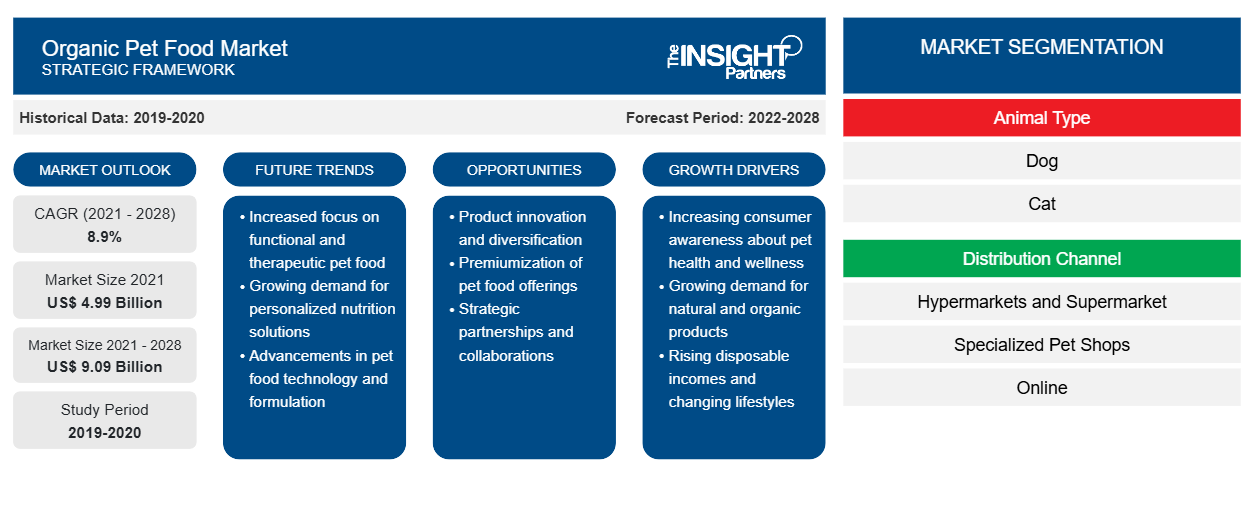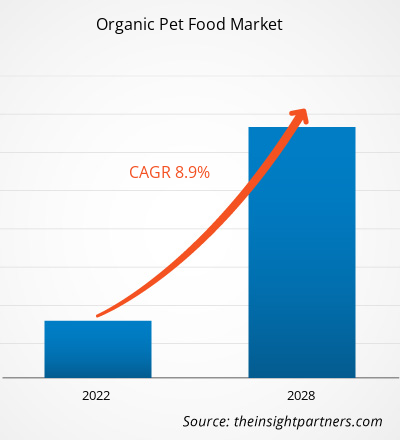2021 年有机宠物食品市场价值为 49.9154 亿美元,预计到 2028 年将达到 90.902 亿美元;预计 2021 年至 2028 年的复合年增长率为 8.9%。
由于宠物的人性化程度不断提高,导致宠物产品支出增加,有机宠物食品正受到追捧。购买有机产品的消费者也为他们的宠物采用了同样的购买行为。他们要求有机宠物食品有清洁标签,以防止传统宠物食品中合成和化学添加剂的有害副作用。
2020 年,北美占据全球有机宠物食品市场的最大份额。然而,据估计,在预测期内,亚太地区的市场复合年增长率最高。亚太市场包括中国、印度、日本、韩国和澳大利亚等几个发展中和发达经济体。这些经济体的中产阶级人口正在激增,再加上城市化进程的增长,为有机宠物食品市场的主要参与者提供了丰厚的机会。亚太地区宠物数量的增加和消费者对有机宠物食品的倾向日益增加推动了市场的增长。此外,宠物人性化的提高将在预测期内推动亚太地区有机宠物食品市场的增长。
定制此报告以满足您的需求
您可以免费定制任何报告,包括本报告的部分内容、国家级分析、Excel 数据包,以及为初创企业和大学提供优惠和折扣
- 获取此报告的关键市场趋势。这个免费样品将包括数据分析,从市场趋势到估计和预测。
COVID-19 疫情对有机宠物食品市场的影响
由于不同地区的长期封锁、对国际贸易的限制、制造单位的关闭、旅行禁令、供应链限制和原材料短缺,COVID-19 疫情严重扰乱了制造业的运营效率。由于制造单位关闭、原材料价格上涨、劳动力短缺、供应链中断和金融不稳定,疫情影响了全球有机宠物食品市场。各国政府在 2020 年初实施封锁以限制病毒传播,这反过来又对有机宠物食品的生产产生了负面影响。各国政府要求宠物食品制造商推迟生产,这对全球食品和宠物食品(包括有机宠物食品)的供应产生了不利影响。然而,自 2021 年以来,亚太地区各国政府一直在为人们提供疫苗接种,并采取预防措施来控制新型冠状病毒的传播。各国政府还重新调整了运营,重组了生产设施,并提前采购了有机宠物食品所需的原材料,以避免供需失衡。此外,疫情期间,电子商务网络在食品和宠物食品产品分销中发挥着重要作用,人们大多更喜欢在网上购买产品。
市场洞察
食源性危害病例不断增加
卫生健康的宠物食品是确保宠物健康的基础。因此,宠物主人更喜欢购买优质的宠物食品。标有“整体”、“有机”和“天然”的食品比传统产品更能吸引顾客。宠物食品通常由食品加工行业的副产品制成,例如鸡皮和骨头。如果所用的原料被添加抗生素,这种做法可能会导致食源性疾病。必须维护宠物食品从第一步处理到最后一步的供应链,以防止可能通过宠物食品传播的食源性疾病。在许多情况下,主人给宠物喂食生食宠物食品,都会发现沙门氏菌污染的发生率。此外,食品的人工强化可能会损害宠物动物的健康并影响品牌名称。例如,Fromm Family Foods 品牌于 2021 年 10 月召回狗粮,原因是维生素 D 含量可能升高,预计这会对狗有害。有机贸易协会 (OTA) 报告称,有机宠物食品的销售额增长高于人类有机食品的销售额。此外,自 2007 年 Menu Foods Inc. 召回宠物食品导致美国 14 只动物死亡以来,有机宠物食品市场一直在增长。由于消费者对传统宠物食品的担忧,有机宠物食品市场的销量大幅飙升。因此,有机宠物食品是一种安全的选择。因此,预计市场在预测期内将实现高增长。
产品类型洞察
根据产品类型,有机宠物食品市场分为干粮、湿粮和其他。干粮部分在 2020 年占据了最大的市场份额,预计在预测期内将在市场上实现最高的复合年增长率。干粮含水量低,有各种形式,如颗粒、粗粒和片状谷物。干狗粮是通过混合和烹饪肉类和谷物等成分制成的。干宠物食品通过减少牙菌斑积聚来确保狗和猫的牙齿健康。干宠物食品不需要冷藏,这是主要优点。食物中还含有微量营养素以及日常营养需求。
宠物类型洞察
根据宠物类型,有机宠物食品市场分为狗、猫和其他。狗类在 2020 年占据了最大的市场份额,而猫类预计在预测期内将实现最高的市场复合年增长率。猫是世界各地人们最喜欢的宠物之一。猫是专性食肉动物。它们的饮食要求与其他动物不同。牛磺酸、精氨酸、组氨酸、异亮氨酸、亮氨酸、赖氨酸、蛋氨酸、苯丙氨酸、苏氨酸、色氨酸和缬氨酸等氨基酸对它们的生长、繁殖、肠道健康和骨骼健康至关重要。此外,牛磺酸通常存在于动物性食物中。此外,猫需要大量的维生素 A 来促进其生长和健康。有机宠物食品现在强化了各种微量营养素,这些微量营养素对猫的生长和整体健康至关重要,这推动了对猫有机宠物食品的需求。植物性湿粮等创新产品预计将进一步推动有机宠物食品市场对猫类的需求。
分销渠道洞察
根据分销渠道,有机宠物食品市场细分为超市和大卖场、专卖店、在线零售和其他。超市和大卖场部分在 2020 年占据了最大的市场份额,而在线零售部分预计在预测期内将在市场上实现最高的复合年增长率。电子商务平台为世界各地的客户提供各种类别的广泛产品。消费者可以在家里或办公室购买自己选择的产品。在线零售是有机宠物食品增长最快的分销渠道,因为在线零售易于获取、产品种类繁多,并且在产品交付、现金返还、折扣券和诱人交易方面提供了便利。此外,由于 COVID-19 大流行期间对实体店购物的限制,预计未来几年在线零售市场将出现显着增长。
Tender and True Pet Nutrition;Castor and Pollux Natural Petworks;雀巢;Raw Paws Pet, Inc.;NATIVE PET;Primal Pet Foods;Yarrah Organic Petfood BV;Organic Paws;Petcurean 和 Evangers 是有机宠物食品市场的主要参与者。这些公司为市场提供广泛的产品组合。市场参与者正在开发高质量和创新的产品来满足客户的需求。这些公司正在推出畅销传统宠物食品的有机版本,以满足对有机宠物食品日益增长的需求。例如,植物性宠物食品产品现在被引入有机标签类别,有蔓越莓、甜菜根和胡萝卜等口味可供选择。
有机宠物食品市场区域洞察
Insight Partners 的分析师已详细解释了预测期内影响有机宠物食品市场的区域趋势和因素。本节还讨论了北美、欧洲、亚太地区、中东和非洲以及南美和中美洲的有机宠物食品市场细分和地理位置。

- 获取有机宠物食品市场的区域特定数据
有机宠物食品市场报告范围
| 报告属性 | 细节 |
|---|---|
| 2021 年市场规模 | 49.9 亿美元 |
| 2028 年市场规模 | 90.9 亿美元 |
| 全球复合年增长率(2021 - 2028) | 8.9% |
| 史料 | 2019-2020 |
| 预测期 | 2022-2028 |
| 涵盖的领域 | 按动物类型
|
| 覆盖地区和国家 | 北美
|
| 市场领导者和主要公司简介 |
|
有机宠物食品市场参与者密度:了解其对业务动态的影响
有机宠物食品市场正在快速增长,这得益于终端用户需求的不断增长,而这些需求又源于消费者偏好的不断变化、技术进步以及对产品优势的认识不断提高等因素。随着需求的增加,企业正在扩大其产品范围,进行创新以满足消费者的需求,并利用新兴趋势,从而进一步推动市场增长。
市场参与者密度是指在特定市场或行业内运营的企业或公司的分布情况。它表明在给定市场空间中,相对于其规模或总市场价值,有多少竞争对手(市场参与者)存在。
在有机宠物食品市场运营的主要公司有:
- 温柔而真实的宠物营养
- CASTOR & POLLUX 天然宠物用品
- 雀巢
- RAW PAWS 宠物公司
- 原生宠物
免责声明:上面列出的公司没有按照任何特定顺序排列。

- 获取有机宠物食品市场顶级关键参与者概览
报告亮点
- 有机宠物食品市场的渐进式行业趋势可帮助参与者制定有效的长期战略
- 发达市场和发展中市场采用的业务增长战略
- 2019 年至 2028 年有机宠物食品市场的定量分析
- 全球有机宠物食品需求估计
- 波特的五力分析说明了行业中买家和供应商的效力
- 了解竞争市场状况的最新发展
- 市场趋势和前景以及推动和抑制有机宠物食品市场增长的因素
- 通过强调支撑商业利益的市场策略来协助决策过程,从而促进市场增长
- 有机宠物食品市场规模在不同节点的大小
- 市场详细概述和细分,以及有机宠物食品行业动态
- 各地区有机宠物食品市场规模及增长潜力
有机宠物食品市场 – 按产品类型
- 干粮
- 湿食
- 其他的
有机宠物食品市场 – 按宠物类型
- 狗
- 猫
- 其他的
有机宠物食品市场 – 按分销渠道
- 超市和大卖场
- 专卖店
- 网上零售
- 其他的
公司简介
- 温柔而真实的宠物营养
- Castor 和 Pollux 天然宠物店
- 雀巢
- Raw Paws 宠物公司
- 原生宠物
- 原始宠物食品
- Yarrah 有机宠物食品 BV
- 有机爪子
- 佩特库里安
- 埃文格斯
- 历史分析(2 年)、基准年、预测(7 年)及复合年增长率
- PEST 和 SWOT 分析
- 市场规模价值/数量 - 全球、区域、国家
- 行业和竞争格局
- Excel 数据集


- Machine Condition Monitoring Market
- Investor ESG Software Market
- Truck Refrigeration Market
- Artwork Management Software Market
- Employment Screening Services Market
- GNSS Chip Market
- Fertilizer Additives Market
- Airline Ancillary Services Market
- EMC Testing Market
- Rare Neurological Disease Treatment Market

Report Coverage
Revenue forecast, Company Analysis, Industry landscape, Growth factors, and Trends

Segment Covered
This text is related
to segments covered.

Regional Scope
North America, Europe, Asia Pacific, Middle East & Africa, South & Central America

Country Scope
This text is related
to country scope.
常见问题
In 2020, the supermarkets and hypermarkets segment accounted for the largest market share. Supermarkets and hypermarkets are big retail stores that offer groceries, vegetables, dairy products, and packaged food products under one roof. They also give discounts and attractive offers to their loyal customers. These stores offer a wide variety of products where customers have freedom of selecting their choice of products. Supermarkets and hypermarkets are among the most preferred distribution channels for the organic pet food market due to the availability of a wide range of products with famous brands under one roof, the convenience of selecting the products, discounts, and attractive deals, and others.
In 2020, dogs held the largest market share in the global organic pet food market. According to the National Pet Owners Survey, conducted by the American Pet Products Association, during 2020–2021, pet dog ownership has increased by an estimated 67% in US households. Dogs can be fed with organic pet food, which is clean, light, and highly nutritious. Organic pet food helps in managing the weight of dogs and improves their energy levels. Moreover, it is easily digestible, which helps in improving the gut health of dogs and overcoming the problems of constipation and loose stools. Dogs require specific proteins, carbohydrates, fats, vitamins, amino acids, minerals, and other nutrients. Organic pet food is fortified with nutrients that fulfil the dietary requirements of dogs.
On the basis of distribution channel, online retail is the fastest growing segment. E-commerce platforms offer a wide range of products of various categories to customers across the globe. Consumers can buy the product of their choice just by sitting at their homes or offices. Online retail is the fastest-growing distribution channel for organic pet food market owing to factors such as ease of accessibility, availability of a wide range of products; the convenience offered by these channels in terms of delivery of the products, cashback, discount coupons, and attractive deals. Due to the disruption of physical stores due to the COVID-19 pandemic and lockdowns, this segment is expected to register notable growth over the next few years.
In 2020, the dry food segment accounted for the largest market share. Dry foods are low in moisture content and are available in various forms, such as pellets, kibbles, flaked cereals, and others. Pet food is made by combining and cooking various ingredients, such as meat and grains. Dry pet foods ensure the teeth health of dogs and cats by reducing plaque build-up. It does not require refrigeration which is the main advantage over wet food. Dry pet food contains nutrients and vitamins as well, which help in the growth of the pet.
The major players operating in the global organic pet food market are Tender & True Pet Nutrition; Castor & Pollux Natural Petworks; Nestlé; Raw Paws Pet, Inc.; Native Pet; Primal Pet Foods; Yarrah Organic Petfood B.V.; Organic Paws; Petcurean; And Evanger’s.
In 2020, North America accounted for the largest share of the global organic pet food market. The rising demand for organic and natural pet food can be related to increase pet ownership and a rise in consumer awareness of pet health. Additionally, the introduction of private label retail brands and increase in urbanization and disposable incomes are among the primary factors propelling the organic pet food market's growth in North America. Organic pet food consists of organic components that are free of synthetic fertilizers, pesticides, antibiotics, artificial coloring, and chemical byproducts.
Trends and growth analysis reports related to Food and Beverages : READ MORE..
The List of Companies - Organic Pet Food Market
- TENDER & TRUE PET NUTRITION
- CASTOR & POLLUX NATURAL PETWORKS
- Nestlé
- RAW PAWS PET, INC.
- NATIVE PET
- PRIMAL PET FOODS
- YARRAH ORGANIC PETFOOD B.V.
- ORGANIC PAWS
- PETCUREAN
- EVANGER’S
The Insight Partners performs research in 4 major stages: Data Collection & Secondary Research, Primary Research, Data Analysis and Data Triangulation & Final Review.
- Data Collection and Secondary Research:
As a market research and consulting firm operating from a decade, we have published and advised several client across the globe. First step for any study will start with an assessment of currently available data and insights from existing reports. Further, historical and current market information is collected from Investor Presentations, Annual Reports, SEC Filings, etc., and other information related to company’s performance and market positioning are gathered from Paid Databases (Factiva, Hoovers, and Reuters) and various other publications available in public domain.
Several associations trade associates, technical forums, institutes, societies and organization are accessed to gain technical as well as market related insights through their publications such as research papers, blogs and press releases related to the studies are referred to get cues about the market. Further, white papers, journals, magazines, and other news articles published in last 3 years are scrutinized and analyzed to understand the current market trends.
- Primary Research:
The primarily interview analysis comprise of data obtained from industry participants interview and answers to survey questions gathered by in-house primary team.
For primary research, interviews are conducted with industry experts/CEOs/Marketing Managers/VPs/Subject Matter Experts from both demand and supply side to get a 360-degree view of the market. The primary team conducts several interviews based on the complexity of the markets to understand the various market trends and dynamics which makes research more credible and precise.
A typical research interview fulfils the following functions:
- Provides first-hand information on the market size, market trends, growth trends, competitive landscape, and outlook
- Validates and strengthens in-house secondary research findings
- Develops the analysis team’s expertise and market understanding
Primary research involves email interactions and telephone interviews for each market, category, segment, and sub-segment across geographies. The participants who typically take part in such a process include, but are not limited to:
- Industry participants: VPs, business development managers, market intelligence managers and national sales managers
- Outside experts: Valuation experts, research analysts and key opinion leaders specializing in the electronics and semiconductor industry.
Below is the breakup of our primary respondents by company, designation, and region:

Once we receive the confirmation from primary research sources or primary respondents, we finalize the base year market estimation and forecast the data as per the macroeconomic and microeconomic factors assessed during data collection.
- Data Analysis:
Once data is validated through both secondary as well as primary respondents, we finalize the market estimations by hypothesis formulation and factor analysis at regional and country level.
- Macro-Economic Factor Analysis:
We analyse macroeconomic indicators such the gross domestic product (GDP), increase in the demand for goods and services across industries, technological advancement, regional economic growth, governmental policies, the influence of COVID-19, PEST analysis, and other aspects. This analysis aids in setting benchmarks for various nations/regions and approximating market splits. Additionally, the general trend of the aforementioned components aid in determining the market's development possibilities.
- Country Level Data:
Various factors that are especially aligned to the country are taken into account to determine the market size for a certain area and country, including the presence of vendors, such as headquarters and offices, the country's GDP, demand patterns, and industry growth. To comprehend the market dynamics for the nation, a number of growth variables, inhibitors, application areas, and current market trends are researched. The aforementioned elements aid in determining the country's overall market's growth potential.
- Company Profile:
The “Table of Contents” is formulated by listing and analyzing more than 25 - 30 companies operating in the market ecosystem across geographies. However, we profile only 10 companies as a standard practice in our syndicate reports. These 10 companies comprise leading, emerging, and regional players. Nonetheless, our analysis is not restricted to the 10 listed companies, we also analyze other companies present in the market to develop a holistic view and understand the prevailing trends. The “Company Profiles” section in the report covers key facts, business description, products & services, financial information, SWOT analysis, and key developments. The financial information presented is extracted from the annual reports and official documents of the publicly listed companies. Upon collecting the information for the sections of respective companies, we verify them via various primary sources and then compile the data in respective company profiles. The company level information helps us in deriving the base number as well as in forecasting the market size.
- Developing Base Number:
Aggregation of sales statistics (2020-2022) and macro-economic factor, and other secondary and primary research insights are utilized to arrive at base number and related market shares for 2022. The data gaps are identified in this step and relevant market data is analyzed, collected from paid primary interviews or databases. On finalizing the base year market size, forecasts are developed on the basis of macro-economic, industry and market growth factors and company level analysis.
- Data Triangulation and Final Review:
The market findings and base year market size calculations are validated from supply as well as demand side. Demand side validations are based on macro-economic factor analysis and benchmarks for respective regions and countries. In case of supply side validations, revenues of major companies are estimated (in case not available) based on industry benchmark, approximate number of employees, product portfolio, and primary interviews revenues are gathered. Further revenue from target product/service segment is assessed to avoid overshooting of market statistics. In case of heavy deviations between supply and demand side values, all thes steps are repeated to achieve synchronization.
We follow an iterative model, wherein we share our research findings with Subject Matter Experts (SME’s) and Key Opinion Leaders (KOLs) until consensus view of the market is not formulated – this model negates any drastic deviation in the opinions of experts. Only validated and universally acceptable research findings are quoted in our reports.
We have important check points that we use to validate our research findings – which we call – data triangulation, where we validate the information, we generate from secondary sources with primary interviews and then we re-validate with our internal data bases and Subject matter experts. This comprehensive model enables us to deliver high quality, reliable data in shortest possible time.


 获取此报告的免费样本
获取此报告的免费样本